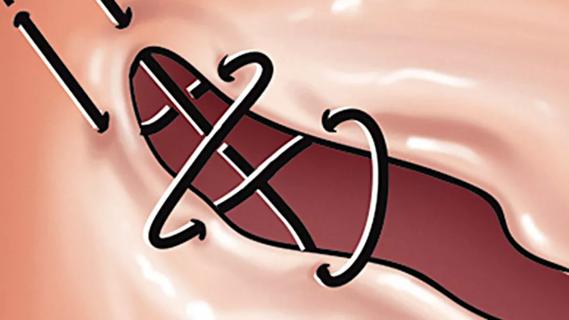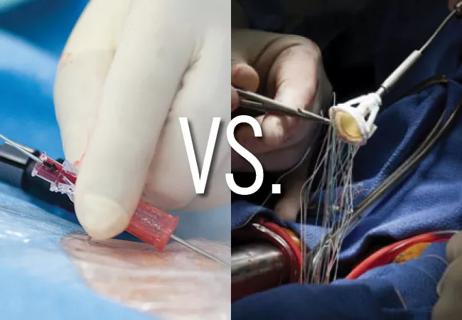Experience-based takes on valve-sparing root replacement from two expert surgeons
About 10% of the aortic root operations in the United States each year are done at Cleveland Clinic, which performed some 730 aortic root operations in 2024 alone. Many of these are valve-sparing aortic root replacements, which treat aortic aneurysms while preserving the patient’s native aortic valve.
Advertisement
Cleveland Clinic is a non-profit academic medical center. Advertising on our site helps support our mission. We do not endorse non-Cleveland Clinic products or services. Policy
“Our experience means we have seen pretty much any problem that can arise in these valve-sparing root reimplantations,” says Cleveland Clinic Heart, Vascular and Thoracic Institute Chief Lars Svensson, MD, PhD, who pioneered various refinements to the procedure. “We have standardized the operation and developed modifications that we believe have contributed to the excellent long-term outcomes and durability of these surgeries.”
Those outcomes are borne out by a recent long-term study of about 500 patients who underwent elective valve-sparing root replacement at Cleveland Clinic, which reported no operative deaths and 95% freedom from reintervention at 15 years. Those trends have continued through current cumulative volumes of nearly 600 patients.
In a new episode of Cleveland Clinic’s Cardiac Consult podcast, Dr. Svensson is joined by his cardiothoracic surgeon colleague Xiaoying Lou, MD, who also performs a high volume of valve-sparing aortic root replacements. Together they share insights on what these complex operations involve and considerations for patients and referring providers. Their discussion touches on the following:
Advertisement
Click the podcast player above to listen to the 24-minute episode now or read on for an edited excerpt. Check out more Cardiac Consult episodes at clevelandclinic.org/cardiacconsultpodcast or wherever you get your podcasts.
Lars Svensson, MD, PhD: What is your approach to patients who have an aortic root aneurysm and a bicuspid valve?
Xiaoying Lou, MD: That type of a situation is a bit of a different beast. We have to approach those cases very carefully. Bicuspid valves oftentimes do have a bit more calcium. The raphe can be somewhat calcified, and there can be some abnormal commissures as well. The development is different for those particular valves, so it can be hard to know exactly what we’re getting into until we can look and actually see the valve leaflets and assess them and the other anatomy. But that’s not to say that we can’t save a bicuspid valve, even with some moderate aortic insufficiency present. We save a lot of those and we have good outcomes with those patients, but they definitely require closer follow-up.
So it’s very much a case-by-case decision, but we’ve had a good run of being able to help a lot of these patients who have bicuspid valves. Even if we save their valve, they obviously still have a bicuspid valve, so we have to be careful that we have confidence we can offer a durable result. Sometimes we can shave a little bit of calcium and fix the raphe, but if you’re doing multiple different fixes to try to save a bicuspid valve, that may not be a valve that’s going to have a durable result. That patient may be better off just having their valve replaced.
Advertisement
Dr. Svensson: That’s an excellent summary. It’s true that we don’t have the ideal operation for patients with bicuspid valves and aortic root aneurysms. We’ve looked at various approaches — reimplantations, remodelings, various other approaches. So far we haven’t seen in our data a significant difference in outcomes with reimplantations involving bicuspid valves. But the trend suggests the long-term results may not be as good. The bicuspid valve is an abnormal valve, and it will give in over time. We know that from other studies where we’ve compared three-leaflet valves with bicuspid valves in repairs without root aneurysms.
With a reimplantation, a valve may last perhaps 20 years, but there’s a big variability in the durability of bicuspid valve reimplantation operations. If there is calcium, as you mentioned, we lean toward replacing the valve with a mechanical valve or a biological valve. Those are really the two major options. We don't recommend the Ross procedure in patients with root aneurysms or aortic valve regurgitation because it has a higher failure rate over time. But the Ross procedure is a good operation for all young people with aortic valve stenosis.
Advertisement
Advertisement

30-year study of Cleveland Clinic experience shows clear improvement from year 2000 onward

Surgeons credit good outcomes to experience with complex cases and team approach

For many patients, repair is feasible, durable and preferred over replacement

In experienced hands, up to 95% of patients can be free of reoperation at 15 years

Experience and strength in both SAVR and TAVR make for the best patient options and outcomes

Ideal protocols feature frequent monitoring, high-quality imaging and a team approach

20 years of Cleveland Clinic experience in ~500 patients with proximal aortic aneurysm or dilation

Questions remain following late mortality signal from a retrospective cohort study